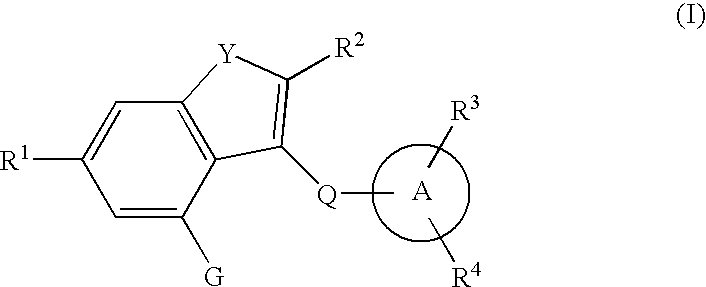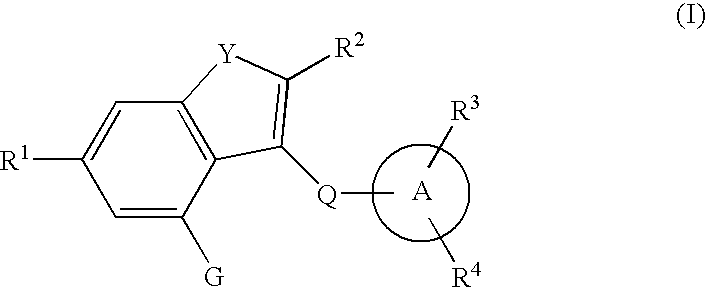Fused heterocyclic derivative, medicinal composition containing the same, and medicinal use thereof
a heterocyclic derivative and derivative technology, applied in the field of fused heterocyclic derivatives, can solve the problems of impaired glucose tolerance, control and continuous performance, and the occasional adverse effects of biguanides and sulfonylureas
- Summary
- Abstract
- Description
- Claims
- Application Information
AI Technical Summary
Benefits of technology
Problems solved by technology
Method used
Image
Examples
reference example 1
2′-Benzyloxy-6′-hydroxyacetophenone
[0232]To a mixture of 2′,6′-dihydroxyacetophenone (4 g) and potassium carbonate (3.82 g) in acetone (40 mL) was added benzyl bromide (3.13 mL), and the mixture was stirred at room temperature overnight. The reaction mixture was poured into water, and the precipitated crystals were collected by filtration. The crystals were washed with water and n-hexane, and dried under reduced pressure to give the title compound (3.67 g).
[0233]1H-NMR (CDCl3) δ ppm: 2.62 (3H, s), 5.13 (2H, s), 6.45-6.5 (1H, m), 6.55-6.65 (1H, m), 7.3-7.5 (6H, m), 13.22 (1H, s)
reference example 2
2′-Benzyloxy-6′-hydroxy-4-methylchalcone
[0234]To a suspension of 2′-benzyloxy-6′-hydroxyacetophenone (0.5 g) in ethanol (10 mL)-water (3 mL) was added potassium hydroxide (1.39 g), and the mixture was stirred at room temperature for 10 minutes. To the reaction mixture was added p-tolualdehyde (0.37 mL), and the mixture was stirred at room temperature for 45 minutes. The reaction mixture was acidified by addition of 2 mol / L hydrochloric acid (12.5 mL), and the precipitated crystals were collected by filtration. The crystals were washed with water and dried under reduced pressure to give the title compound (0.69 g).
[0235]1H-NMR (CDCl3) δ ppm: 2.35 (3H, s), 5.13 (2H, s), 6.5-6.6 (1H, m), 6.6-6.7 (1H, m), 7.0-7.1 (4H, m), 7.25-7.55 (6H, m), 7.75 (1H, d, J=15.7 Hz), 7.86 (1H, d, J=15.7 Hz), 13.53 (1H, s)
reference example 3
2′-Benzyloxy-6′-hydroxychalcone
[0236]The title compound was prepared in a similar manner to that described in Reference Example 2 using benzaldehyde instead of p-tolualdehyde.
[0237]1H-NMR (CDCl3) δ ppm: 5.13 (2H, s), 6.55 (1H, d, J=8.1 Hz), 6.66 (1H, d, J=8.2 Hz), 7.1-7.15 (2H, m), 7.15-7.45 (7H, m), 7.45-7.55 (2H, m), 7.75 (1H, d, J=15.8 Hz), 7.88 (1H, d, J=15.8 Hz), 13.48 (1H, s)
PUM
| Property | Measurement | Unit |
|---|---|---|
| RI | aaaaa | aaaaa |
| temperature | aaaaa | aaaaa |
| temperature | aaaaa | aaaaa |
Abstract
Description
Claims
Application Information
 Login to View More
Login to View More - R&D
- Intellectual Property
- Life Sciences
- Materials
- Tech Scout
- Unparalleled Data Quality
- Higher Quality Content
- 60% Fewer Hallucinations
Browse by: Latest US Patents, China's latest patents, Technical Efficacy Thesaurus, Application Domain, Technology Topic, Popular Technical Reports.
© 2025 PatSnap. All rights reserved.Legal|Privacy policy|Modern Slavery Act Transparency Statement|Sitemap|About US| Contact US: help@patsnap.com



